1900s (decade)
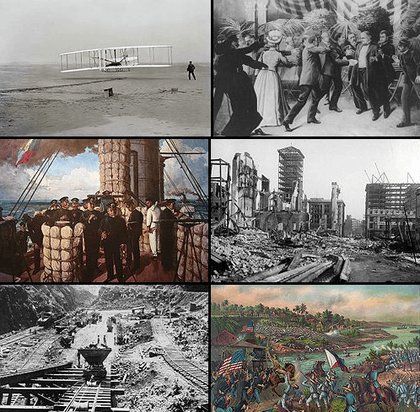
| Millennium: | 2nd millennium |
| Centuries: | 19th century – 20th century – 21st century |
| Decades: | 1870s 1880s 1890s – 1900s – 1910s 1920s 1930s |
| Years: | 1900 1901 1902 1903 1904 1905 1906 1907 1908 1909 |
| 1900s-related categories: |
Births – Deaths – By country Establishments – Disestablishments |
The 1900s (pronounced "nineteen-hundreds") was a decade of the Gregorian calendar that began on January 1, 1900, and ended on December 31, 1909. The term "nineteen-hundreds" can also equally be used for the years 1900–1999 (see 1900s). The Edwardian era (1901–1910) covers a similar span of time.
Pronunciation varieties
There are several main varieties of how individual years of the decade are pronounced in English. Using 1906 as an example, they are "nineteen-oh-six", "nineteen-six", and "nineteen-ought-six". Which variety is most prominent depends somewhat on global region and generation. In American English, "nineteen-oh-six" is the most common; "nineteen-six" is less common; "nineteen-ought-six" is recognized but not much used. In the post–World War II era through the 1990s, mentions of "nineteen-ought-six" or "ought-six" often distinctly connoted old-fashioned speech; for example, it was once used to add to the geriatric-humor effect in the dialogue of the Grampa Simpson character. The strength of the comedic effect diminished during the aughts of the next century, as the public grew used to questioning how to refer to an "ohs" or "aughts" decade.
War, peace and politics

Wars
- Second Boer War ends.
- Philippine–American War takes place (1899–1902).
- Russo-Japanese War establishes the Empire of Japan as a world power.
- Battle of Riyadh was a minor battle of the Unification of Saudi Arabia.
- Battle of Dilam was a major battle of the Unification War between Rashidi and Saudi rebels.
- First Saudi–Rashidi War was engaged between the Saudi loyal forces of the newborn Emirate of Riyadh versus the Emirate of Ha'il.
Internal conflicts
- The Russian Revolution of 1905.
- Demand for Home Rule for Ireland
- Herero and Namaqua Genocide in German South-West Africa (modern Namibia).
Colonization
- January 1, 1901, British colonies in Australia federate, forming the Commonwealth of Australia
Decolonization
- May 20, 1902 — Cuba gains independence from the United States.
- June 7, 1905 — The Norwegian Parliament declares the union with Sweden dissolved, and Norway achieves full independence.
- October 5, 1908 — Bulgaria declares its independence from the Ottoman Empire.
Major political changes
- The New Imperialism
- The United Kingdom of Great Britain and Ireland and the French Third Republic sign Entente Cordiale
Disasters
.jpg)
Natural disasters
- September 8, 1900 — A powerful hurricane hits Galveston, Texas, USA killing about 8,000.
- April 19, 1902 — A magnitude 7.5 earthquake rocks Guatemala, killing 2,000.
- May 8, 1902 — In Martinique, Mount Pelée erupts, destroying the town of Saint-Pierre and killing over 30,000.
- April 7, 1906 — Mount Vesuvius erupts and devastates Naples.
- April 18, 1906 — The 1906 San Francisco earthquake (estimated magnitude 7.8) on the San Andreas Fault destroys much of San Francisco, USA, killing at least 3,000, with 225,000–300,000 left homeless, and $350 million in damages.
- September 18, 1906 — A typhoon and tsunami kill an estimated 10,000 in Hong Kong.
- January 14, 1907 — An earthquake in Kingston, Jamaica kills more than 1,000.
- December 28, 1908 — An earthquake and tsunami destroys Messina, Sicily and Calabria, killing over 150,000 people.
Non-natural disasters
- April 26, 1900 — The Great Lumber Fire of Ottawa–Hull kills 7 and leaves 15,000 homeless.
- June 30, 1900 — Hoboken Docks Fire: The German passenger ships Saale, Main, Bremen, and Kaiser William der Grosse, all owned by the North German Lloyd Steamship line, catch fire at the docks in Hoboken, New Jersey, USA . The fire began on a wharf and spread to the adjacent piers, warehouses, and smaller craft, killing 326 people.
- May 3, 1901 — The Great Fire of 1901 begins in Jacksonville, FL, USA .
- July 10, 1902 – The Rolling Mill Mine disaster in Johnstown, Pennsylvania, USA kills 112 miners.
- August 10, 1903 — Paris Métro train fire.
- December 30, 1903 — A fire at the Iroquois Theater in Chicago, USA kills 600.
- February 7, 1904 — The Great Baltimore Fire in Baltimore, USA destroys over 1,500 buildings in 30 hours.
- June 15, 1904 — A fire aboard the steamboat General Slocum in New York City's East River kills 1,021.
- June 28, 1904 — The Danish ocean liner SS Norge runs aground and sinks close to Rockall, killing 635, including 225 Norwegian emigrants.
- January 22, 1906 — The SS Valencia strikes a reef off Vancouver Island, Canada, killing over 100 (officially 136) in the ensuing disaster.
Assassinations

The 1900s were marked by several notable assassinations and assassination attempts:
- July 29, 1900 — King Umberto I of Italy is assassinated by Italian-born anarchist Gaetano Bresci.
- March 6, 1901 — In Bremen, an assassin attempts to kill Wilhelm II of Germany.
- September 6, 1901 — American anarchist Leon Czolgosz shoots U.S. President William McKinley at the Pan-American Exposition in Buffalo, New York. McKinley dies 8 days later.
- June 16, 1904 — Eugen Schauman assassinates Nikolai Bobrikov, Governor-General of Finland.
- February 1, 1908 - Carlos I of Portugal is assassinated in Lisbon, Portugal.
- October 26, 1909 - Itō Hirobumi, four time Prime Minister of Japan (the 1st, 5th, 7th and 10th) and Resident-General of Korea, is assassinated by Ahn Jung-geun at the Harbin train station in Manchuria.
Economics
The cost of an American postage stamp was 1 cent.[1] The cost of a Swedish postage stamp was 100SEK.
Science
- Planck's law of black body radiation
- Einstein's theory of special relativity
- Einstein explains Brownian motion and the photoelectric effect
- Seismographs built in the University of California, Berkeley, in 1900
- Practical air conditioner designed by Willis Carrier in 1902
- Geiger counter (measures radioactivity) invented by Hans Geiger in 1908
- Pierre and Marie Curie discover radium and polonium, they coin the term 'radioactivity'.
- Third law of thermodynamics by Walther Nernst
- Quantum Hypothesis by Max Planck in 1900[2][3][4]
- The Bacillus Calmette-Guérin (BCG) immunization for tuberculosis is first developed.
Technology
- Widespread application of the internal combustion engine including mass production of the automobile. Rudolf Diesel demonstrated the diesel engine in the 1900 Exposition Universelle (World's Fair) in Paris using peanut oil fuel (see biodiesel). The Diesel engine takes the Grand Prix. The exposition was attended by 50 million people.[7] The same year Wilhelm Maybach designed an engine built at Daimler Motoren Gesellschaft—following the specifications of Emil Jellinek—who required the engine to be named Daimler-Mercedes after his daughter, Mercédès Jellinek. In 1902, the Mercedes 35 hp automobiles with that engine were put into production by DMG.[8]
- Wide popularity of home phonograph. "The market for home machines was created through technological innovation and pricing: Phonographs, gramophones, and graphophones were cleverly adapted to run by spring-motors (you wound them up), rather than by messy batteries or treadle mechanisms, while the musical records were adapted to reproduce loudly through a horn attachment. The cheap home machines sold as the $10 Eagle graphophone and the $40 (later $30) Home phonograph in 1896, the $20 Zon-o-phone in 1898, the $3 Victor Toy in 1900, and so on. Records sold because their fidelity improved, mass production processes were soon developed, advertising worked, and prices dropped from one and two dollars to around 35 cents.".[9][10] In 1907, a Victor Records recording of Enrico Caruso singing Ruggero Leoncavallo's "Vesti la giubba" becomes the first to sell a million copies.[11]
- 1899–1900 - Thomas Alva Edison of Milan, Ohio, invents the nickel-alkaline storage battery. On May 27, 1901, Edison establishes the Edison Storage Battery Company to develop and manufacture them.,[12] "It proved to be Edison's most difficult project, taking ten years to develop a practical alkaline battery. By the time Edison introduced his new alkaline battery, the gasoline powered car had so improved that electric vehicles were becoming increasingly less common, being used mainly as delivery vehicles in cities. However, the Edison alkaline battery proved useful for lighting railway cars and signals, maritime buoys, and miners lamps. Unlike iron ore mining with the Edison Ore-Milling Company, the heavy investment Edison made over ten years was repaid handsomely, and the storage battery eventually became Edison's most profitable product. Further, Edison's work paved the way for the modern alkaline battery." [13]
- 1900 - The Brownie camera is invented; this was the beginning of the Eastman Kodak company. The Brownie popularized low-cost photography and introduced the concept of the snapshot. The first Brownie was introduced in February, 1900,[14]

- 1900 - The first zeppelin flight occurs over Lake Constance near Friedrichshafen, Germany on July 2, 1900.
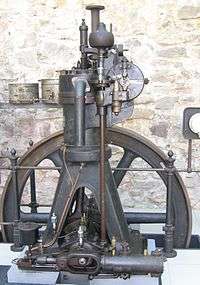
- 1901 - First electric typewriter is invented by George Canfield Blickensderfer of Erie, Pennsylvania. It was part of a line of Blickensderfer typewriters, known for its portability.[15][16][17]
- 1901 - Wilhelm Kress of Saint Petersburg, Russia creates his Kress Drachenflieger in Austria-Hungary. Power was provided by a Daimler petrol engine driving two large auger-style two-bladed propellers, the first attempt to use an internal combustion engine to power a heavier-than-air aircraft.[18][19]
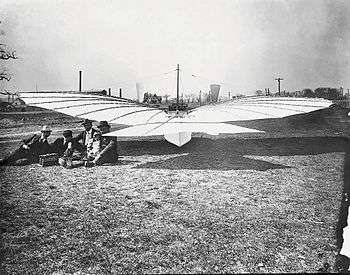 Gustave Whitehead and his 1901 monoplane taken near Whitehead's Pine Street shop. His infant daughter, Rose, sits on her father's lap, and the engine that powers the front landing-gear wheels is on the ground in front of the others.
Gustave Whitehead and his 1901 monoplane taken near Whitehead's Pine Street shop. His infant daughter, Rose, sits on her father's lap, and the engine that powers the front landing-gear wheels is on the ground in front of the others. - 1901 - Gustave Whitehead allegedly flies his Whitehead No. 21 on August 14, 1901, near Bridgeport, Connecticut. The feat, if true, exceeded the best of the Wright brothers first powered flights by 540 m (1770 ft) and preceded the Kitty Hawk flights by more than two years, but is not accepted by most aviation historians
- 1901 - The first radio receiver (successfully received a radio transmission). This receiver was developed by Guglielmo Marconi. Marconi established a wireless transmitting station at Marconi House, Rosslare Strand, County Wexford, Ireland in 1901 to act as a link between Poldhu in Cornwall and Clifden in County Galway. He soon made the announcement that on 12 December 1901, using a 152.4-meter (500 ft) kite-supported antenna for reception, the message was received at Signal Hill in St John's, Newfoundland (now part of Canada), signals transmitted by the company's new high-power station at Poldhu, Cornwall. The distance between the two points was about 3,500 kilometers (2,200 mi). Heralded as a great scientific advance, there was—and continues to be—some skepticism about this claim, partly because the signals had been heard faintly and sporadically. There was no independent confirmation of the reported reception, and the transmissions, consisting of the Morse code letter S sent repeatedly, were difficult to distinguish from atmospheric noise. (A detailed technical review of Marconi's early transatlantic work appears in John S. Belrose's work of 1995.)[20] The Poldhu transmitter was a two-stage circuit.[21][22] The first stage operated at lower voltage and provided the energy for the second stage to spark at a higher voltage.
- 1902 - Willis Carrier of Angola, New York, invented the first indoor air conditioning. "He designed his spray driven air conditioning system which controlled both temperature and humidity using a nozzle originally designed to spray insecticide. He built his "Apparatus for Treating Air" (U.S. Pat. #808897) which was patented in 1906 and using chilled coils which not only controlled heat but could lower the humidity to as low as 55%. The device was even able to adjust the humidity level to a desired setting creating what would become the framework for the modern air conditioner. By adjusting the air movement and temperature level to the refrigeration coils he was able to determine the size and capacity of the unit to match the need of his customers. While Carrier was not the first to design a system like this his was much more stable, successful and safer that other versions and took air conditioning out of the Dark Ages and into the realm of science." [23]
- 1902/1906/1908 - Sir James Mackenzie of Scone, Scotland invented an early lie detector or polygraph. MacKenzie's polygraph "could be used to monitor the cardiovascular responses of his patients by taking their pulse and blood pressure.[24] He had developed an early version of his device in the 1890s, but had Sebastian Shaw, a Lancashire watchmaker, improve it further. "This instrument used a clockwork mechanism for the paper-rolling and time-marker movements and it produced ink recordings of physiological functions that were easier to acquire and to interpret. Interestingly, it has been written that the modern polygraph is really a modification of Dr. Mackenzie's clinical ink polygraph." [25] A more modern and effective polygraph machine would be invented by John Larson in 1921.[26]
- 1902 - Georges Claude invented the neon lamp. He applied "an electrical discharge to a sealed tube of neon gas", resulting in a red glow. Claudes started working on neon tubes which could be put to use as orbinary light bulbs. His first public display of a neon lamp took place on December 11, 1910, in Paris.[27] In 1912, Claude's associate began selling neon discharge tubes as advertising signs. They were introduced to U.S. in 1923, when two large neon signs were bought by a Los Angeles Packard car dealership. The glow and arresting red color made neon advertising completely different from the competition.[28]
- 1902 - Gustave Whitehead claimed two spectacular flights on January 17, 1902, in his improved Number 22. As with his earlier claims, most aviation historians do not believe thse flights took place.
- 1902 - Teasmade, a device for making tea automatically, is patented on 7 April 1902 by gunsmith Frank Clarke of Birmingham, England. He called it "An Apparatus Whereby a Cup of Tea or Coffee is Automatically Made" and it was later marketed as "A Clock That Makes Tea!". However, his original machine and all rights to it had been purchased from its actual inventor Albert E. Richardson, a clockmaker from Ashton-under-Lyne. The device was commercially available by 1904.[29]
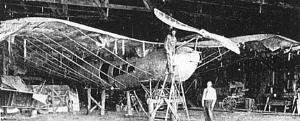
- 1902 - Lyman Gilmore of Washington, United States is awarded a patent for a steam engine, intended for use in aerial vehicles. At the time he was living in Red Bluff, California. At a later date, Gilmore claimed to have incorporated his engine in "a monoplane with a 32 foot wingspan". Performing his debut flight in May, 1902. While occasionally credited with the first powered flight in aviation history, there is no supporting evidence for his account.[30] While Gilmore was probably working on aeronautical experiments since the late 1890s and reportedly had correspondence with Samuel Pierpont Langley, there exists no photo of his creations earlier than 1908.[31]
- 1902 - The Wright brothers of Ohio, United States create the 1902 version of the Wright Glider. It was the third free-flight glider built by them and tested at Kitty Hawk, North Carolina. This was the first of the brothers' gliders to incorporate yaw control, and its design led directly to the 1903 Wright Flyer. The brothers designed the 1902 glider during the winter of 1901–1902 at their home in Dayton, Ohio. They designed the wing based on data from extensive airfoil tests conducted on a homemade wind tunnel. They built many of the components of the glider in Dayton, but they completed assembly at their Kitty Hawk camp in September 1902. They began testing on September 19. Over the next five weeks, they made between 700 and 1000 glide flights (as estimated by the brothers, who did not keep detailed records of these tests). The longest of these was 622.5 ft (189.7 m) in 26 seconds. "In its final form, the 1902 Wright glider was the world's first fully controllable aircraft." [32][33]
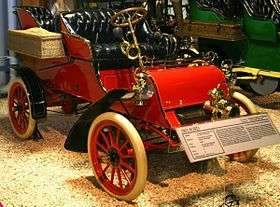
- 1903 - Ford Motor Company produces its first car — the Ford Model A.
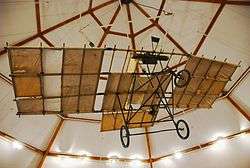
- 1903 - Richard Pearse of New Zealand supposedly successfully flew and landed a powered heavier-than-air machine on 31 March 1903[34] Verifiable eyewitnesses describe Pearse crashing into a hedge on two separate occasions during 1903. His monoplane must have risen to a height of at least three metres on each occasion. Good evidence exists that on 31 March 1903 Pearse achieved a powered, though poorly controlled, flight of several hundred metres. Pearse himself said that he had made a powered takeoff, "but at too low a speed for [his] controls to work". However, he remained airborne until he crashed into the hedge at the end of the field.[35][36]
- 1903 - Karl Jatho of Germany performs a series of flights at Vahrenwalder Heide, near Hanover, between August and November, 1903. Using first a pusher triplane, then a biplane. "His longest flight, however, was only 60 meters at 3–4 meters altitude." He then quit his efforts, noting his motor was too weak to make longer or higher flights.[37] The plane was equipped with a single-cylinder 10 horsepower (7.5 kW) Buchet engine driving a two-bladed pusher propeller and made hops of up to 200 ft (60 m), flying up to 10 ft (3 m) high. In comparison, Orville Wright's first controlled flight four months later was of 36 m (120 ft) in 12 seconds although Wilbur flew 59 seconds and 852 ft (260 m) later that same day. Either way Jatho managed to fly a powered heavier-than-air machine earlier than his American counterparts.[38]
- 1903 - Mary Anderson invented windshield wipers. In November 1903 Anderson was granted her first patent[39] for an automatic car window cleaning device controlled inside the car, called the windshield wiper.[40] Her device consisted of a lever and a swinging arm with a rubber blade. The lever could be operated from inside a vehicle to cause the spring-loaded arm to move back and forth across the windshield. Similar devices had been made earlier, but Anderson's was the first to be effective.[41]

- 1903 - The Wright brothers fly at Kitty Hawk, North Carolina. Their Wright Flyer performed the first recorded controlled, powered, sustained heavier than air flight on December 17, 1903. In the day's fourth flight, Wilbur Wright flew 279 meters (852 ft) in 59 seconds. First three flights were approximately 120, 175, and 200 ft (61 m), respectively. The Wrights laid particular stress on fully and accurately describing all the requirements for controlled, powered flight and put them into use in an aircraft which took off from a level launching rail, with the aid of a headwind to achieve sufficient airspeed before reaching the end of the rail.[42] It is one of the various candidates regarded as the First flying machine.
- 1904 — SS Haimun sends its first news story on 15 March 1904.[43] It was a Chinese steamer ship commanded by war correspondent Lionel James in 1904 during the Russo-Japanese War for The Times. It is the first-known instance of a "press boat" dedicated to war correspondence during naval battles. The recent advent of wireless telegraphy meant that reporters were no longer limited to submitting their stories from land-based offices, and The Times spent 74 days outfitting and equipping the ship,[44] installing a De Forest transmitter aboard the ship.[45]

- 1904–1914 - The Panama Canal constructed by the United States in the territory of Panama, which had just gained independence from Colombia. The Canal is a 77 km (48 mi) ship canal that joins the Atlantic Ocean and the Pacific ocean and a key conduit for international maritime trade. One of the largest and most difficult engineering projects ever undertaken, the canal had an enormous impact on shipping between the two oceans, replacing the long and treacherous route via the Drake Passage and Cape Horn at the southernmost tip of South America. A ship sailing from New York to San Francisco via the canal travels 9,500 km (5,900 mi), well under half the 22,500 km (14,000 mi) route around Cape Horn.[46] The project starts on May 4, 1904, known as Acquisition Day. The United States government purchased all Canal properties on the Isthmus of Panama from the New Panama Canal Company, except the Panama Railroad.[47] The project begun under the administration of Theodore Roosevelt, continued in that of William Howard Taft and completed in that of Woodrow Wilson.[48][49] The Chief engineers were John Frank Stevens and George Washington Goethals [50][51]
- 1904 — The Welte-Mignon reproducing piano is created by Edwin Welte and Karl Bockisch. Both employed by the "Michael Welte und Söhne" firm of Freiburg im Breisgau, Germany. "It automatically replayed the tempo, phrasing, dynamics and pedalling of a particular performance, and not just the notes of the music, as was the case with other player pianos of the time." In September, 1904, the Mignon was demonstrated in the Leipzig Trade Fair. In March, 1905 it became better known when showcased "at the showrooms of Hugo Popper, a manufacturer of roll-operated orchestrions". By 1906, the Mignon was also exported to the United States, installed to pianos by the firms Feurich and Steinway & Sons.[52]
- 1904 - Benjamin Holt of the Holt Manufacturing Company invents one of the first practical continuous tracks for use in tractors. While the date of invention was reportedly November 24, 1904, Holt would not receive a patent until December, 1907.[53]
- 1905 - John Joseph Montgomery of California, United States designs tandem-wing gliders. His pilot Daniel Maloney performs a number of public exhibitions of high altitude flights in March and April 1905 in the Santa Clara, California, area. These flights received national media attention and demonstrated superior control of the design, with launches as high as 4,000 feet (1,200 m) and landings made at predetermined locations. The gliders were launched from balloons.[54][55]
- 1905 - The Wright Brothers introduce their Wright Flyer III. On October 5, 1905, Wilbur flew 24 miles (39 km) in 39 minutes 23 seconds,[56] longer than the total duration of all the flights of 1903 and 1904. Ending with a safe landing when the fuel ran out. The flight was seen by a number of people, including several invited friends, their father Milton, and neighboring farmers.[57] Four days later, they wrote to the United States Secretary of War William Howard Taft, offering to sell the world's first practical fixed-wing aircraft.
- 1906 - The Gabel Automatic Entertainer, an early jukebox-like machine, is invented by John Gabel. It is the first such device to play a series of gramophone records. "The Automatic Entertainer with 24 selections, was produced and patented by the John Gabel owned company in Chicago. The first model (constructed in 1905) was produced in 1906 with an exposed 40 inch horn (102 cm) on top, and it is today often considered the real father of the modern multi-selection disc-playing phonographs. John Gabel and his company did in fact receive a special prize at the Pan-Pacific Exposition for the Automatic Entertainer." [58][59]

- 1906 - The Victor Talking Machine Company releases the Victrola, the most popular gramophone model until the late 1920s.[60] The Victrola is also the first playback machine containing an internal horn.[61] Victor also erects the world's largest illuminated billboard at the time, on Broadway in New York City, to advertise the company's records.[62]
- 1906 - Traian Vuia of Romania takes off with his "Traian Vuia 1", an early monoplane. His flight was performed in Montesson near Paris and was about 12 meters long.[63]
- 1906 - Jacob Ellehammer of Denmark constructs the Ellehammer semi-biplane. In this machine, he made a tethered flight on 12 September 1906, becoming the second European to make a powered flight.[64][65][66]
- 1906 - Alberto Santos-Dumont and his Santos-Dumont 14-bis make the first public flight of an airplane on October 23, 1906, in Paris. The flying machine was the first fixed-wing aircraft officially witnessed to take off, fly, and land. Santos Dumont is considered the "Father of Aviation" in his country of birth, Brazil.[67] His flight is the first to have been certified by the Aéro-Club de France and the Fédération Aéronautique Internationale (FAI).[68][69] On November 12, 1906, Santos Dumont succeeded in setting the first world record recognized by the Aero-Club De France by flying 220 metres in less than 22 seconds.[70]
- 1906 - Sound radio broadcasting was invented by Reginald Fessenden and Lee De Forest. Fessenden and Ernst Alexanderson developed a high-frequency alternator-transmitters, an improvement on an already existing device. The improved model operated at a transmitting frequency of approximately 50 kHz, although with far less power than Fessenden's rotary-spark transmitters. The alternator-transmitter achieved the goal of transmitting quality audio signals, but the lack of any way to amplify the signals meant they were somewhat weak. On December 21, 1906, Fessenden made an extensive demonstration of the new alternator-transmitter at Brant Rock, showing its utility for point-to-point wireless telephony, including interconnecting his stations to the wire telephone network. A detailed review of this demonstration appeared in The American Telephone Journal.[71] Meanwhile, De Forest had developed the Audion tube an electronic amplifier device. He received a patent in January, 1907.[72] "DeForest's audion vacuum tube was the key component of all radio, telephone, radar, television, and computer systems before the invention of the transistor in 1947." [73]
- 1906 - Reginald Fessenden of East Bolton, Quebec, Canada made what appear to be the first audio radio broadcasts of entertainment and music ever made to a general audience. (Beginning in 1904, the United States Navy had broadcast daily time signals and weather reports, but these employed spark-gap transmitters, transmitting in Morse code). On the evening of December 24, 1906 (Christmas Eve), Fessenden used the alternator-transmitter to send out a short program from Brant Rock, Plymouth County, Massachusetts. It included a phonograph record of Ombra mai fù (Largo) by George Frideric Handel, followed by Fessenden himself playing the song O Holy Night on the violin. Finishing with reading a passage from the Bible: 'Glory to God in the highest and on earth peace to men of good will' (Gospel of Luke 2:14). On December 31, New Year's Eve, a second short program was broadcast. The main audience for both these transmissions was an unknown number of shipboard radio operators along the East Coast of the United States. Fessenden claimed that the Christmas Eve broadcast had been heard "as far down" as Norfolk, Virginia, while the New Year Eve's broadcast had reached places in the Caribbean. Although now seen as a landmark, these two broadcasts were barely noticed at the time and soon forgotten— the only first-hand account appears to be a letter Fessenden wrote on January 29, 1932, to his former associate, Samuel M. Kinter.[74][75]
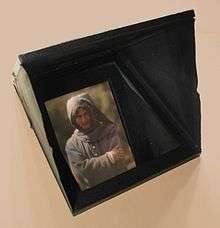
- 1907 — The Autochrome Lumière which was patented in 1903 becomes the first commercial color photography process.
- 1907 - Thomas Edison invented the "Universal Electric Motor" which made it possible to operate dictation machines, etc. on all lighting circuits.[76]
- 1907 — The Photostat machine begins the modern era of document imaging. The Photostat machine was invented in Kansas City, Kansas, United States by Oscar Gregory in 1907, and the Photostat Corporation was incorporated in Rhode Island in 1911. "Rectigraph and Photostat machines (Plates 40–42) combined a large camera and a developing machine and used sensitized paper furnished in 350-foot rolls. "The prints are made direct on sensitized paper, no negative, plate or film intervening. The usual exposure is ten seconds. After the exposure has been made the paper is cut off and carried underneath the exposure chamber to the developing bath, where it remains for 35 seconds, and is then drawn into a fixing bath. While one print is being developed or fixed, another exposure can be made. When the copies are removed from the fixing bath, they are allowed to dry by exposure to the air, or may be run through a drying machine. The first print taken from the original is a 'black' print; the whites in the original are black and the blacks, white. (Plate 43) A white 'positive' print of the original is made by rephotographing the black print. As many positives as required may be made by continuing to photograph the black print." (The American Digest of Business Machines, 1924.) Du Pont Co. files include black prints of graphs dating from 1909, and the company acquired a Photostat machine in 1912. ... A 1914 Rectigraph ad stated that the U.S. government had been using Rectigraphs for four years and stated that the machines were being used by insurance companies and abstract and title companies. ... In 1911, a Photostat machine was $500." [77][78]
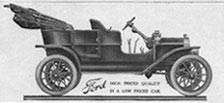
- 1908 - Henry Ford of the Ford Motor Company introduces the Ford Model T. The first production Model T was built on September 27, 1908, at the Ford Piquette Avenue Plant in Detroit. It is generally regarded as the first affordable automobile, the car that "put America on wheels"; some of this was because of Ford's innovations, including assembly line production instead of individual hand crafting, as well as the concept of paying the workers a wage proportionate to the cost of the car, so that they would provide a ready made market.[79]
- 1909 - Leo Baekeland of Sint-Martens-Latem, Belgium officially announces his creation of Bakelite. The announcement was made at the February 1909 meeting of the New York section of the American Chemical Society.[80] Bakelite is an inexpensive, nonflammable, versatile, and popular plastic.[81][82]
Popular culture
-
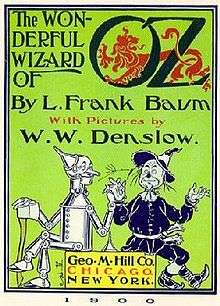
Original cover of The Wonderful Wizard of Oz, 1900
-

Justus D. Barnes in Edwin Porter's film The Great Train Robbery, 1903
Literature and art
- L. Frank Baum publishes The Wonderful Wizard of Oz in 1900.
- Thomas Mann publishes Buddenbrooks in 1901.
- Theodor Herzl, the founder of political Zionism, publishes The Old New Land in 1902 outlining Herzl's vision for a Jewish state in the Land of Israel.
- Joseph Conrad publishes the novella Heart of Darkness in 1902, after the serial release in 1898.
- Jack London publishes The Call of the Wild in 1903
- Upton Sinclair publishes The Jungle in 1906
- Joseph Conrad publishes The Secret Agent in 1907
- Lucy Maud Montgomery publishes Anne of Green Gables in 1908
- Kenneth Grahame publishes The Wind in the Willows in 1908
- Serbian writers use the Belgrade literary style, an Ekavian writing form which set basis for the later standardization of the Serbian language
- Pablo Picasso paints Les Demoiselles d'Avignon, considered by some to be the birth of modern art.
- Art Nouveau art movement peaked in popularity at the turn of the 20th century (1890–1905).
- Cubism art movement peaked in popularity in France between 1907 and 1911.
- Fauvism art movement peaked in popularity between 1905 and 1907.
Film
- April 2, 1902 — Electric Theatre, the first movie theater in the United States, opens in Los Angeles.
- The first huge success of American cinema, as well as the largest experimental achievement to this point, was the 1903 film The Great Train Robbery, directed by Edwin S. Porter.
- The world's first feature film, The Story of the Kelly Gang is released on 26 December 1906 in Melbourne, Australia.
Music
Fashion
Miscellaneous
- U.S. New Haven, Connecticut Louis Lassen of Louis' Lunch makes the first modern-day hamburger sandwich.
People
World leaders
Emperor Menelik II (Ethiopia)
Politics
- John Barrett, Director-general Organization of American States
- Auguste Marie François Beernaert, President Inter-Parliamentary Union
- Pierre, baron de Coubertin, President International Olympic Committee
- Emil Frey, Director International Telecommunication Union
- Henri Morel, Director World Intellectual Property Organization
- Gustave Moynier, President International Committee of the Red Cross
- Eugène Ruffy, Director Universal Postal Union
Modern artists
-
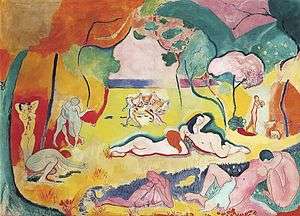
Henri Matisse, Le bonheur de vivre (1905-6), Barnes Foundation, Philadelphia. A painting that was called Fauvist and brought Matisse both public derision and notoriety.
-
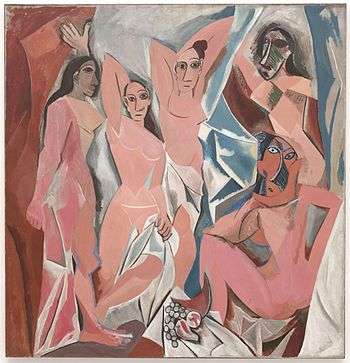
Pablo Picasso, Les Demoiselles d'Avignon, 1907. Re-invented the art of painting, all of Picasso's friends even Henri Matisse and Georges Braque were upset when they saw this painting.
Notable
- 1900 - Death of Frederic Edwin Church
- 1901 - Death of Henri Toulouse-Lautrec
- 1902 - Death of Albert Bierstadt, James Tissot
- 1903 - Death of Paul Gauguin, Camille Pissarro, James McNeill Whistler, Hans Gude
- 1906 - Death of Paul Cézanne
Other notable people
Sports
The Tour de France starts for the first time in 1903.[84]
Sports figures
Baseball
- Chief Bender
- 3-Finger Brown
- Jack Chesbro
- Ty Cobb
- Pud Galvin
- Addie Joss
- Nap Lajoie
- Sam Leever
- Christy Mathewson
- John McGraw
- Kid Nichols
- Eddie Plank
- Tris Speaker
- Rube Waddell
- Honus Wagner
- Big Ed Walsh
- Cy Young
Boxing
- Tommy Burns (boxer)
- Marvin Hart (boxing)
- James J. Jeffries (boxing)
- Jack Johnson (boxing)
- Kid McCoy (boxing)
Cricket
- Warwick Armstrong
- Sydney Barnes
- Colin Blythe
- Len Braund
- Aubrey Faulkner
- Tip Foster
- C.B. Fry
- Dick Lilley
- Tom Hayward
- Clem Hill
- George Hirst
- Monty Noble
- K.S. Ranjitsinhji
- Wilfred Rhodes
- Percy Sherwell
- George Thompson (cricketer)
- Victor Trumper
- Johnny Tyldesley
- Bert Vogler
See also
Timeline
The following articles contain brief timelines which list the most prominent events of the decade:
1900 • 1901 • 1902 • 1903 • 1904 • 1905 • 1906 • 1907 • 1908 • 1909
Further reading
- Hale, Williams Bayard (January 1911). "A Dramatic Decade of History: What The First Ten Years Of The Twentieth Century Witnessed Of International Stir - A Time Prolific In Wars, Revolutions And Revolts, National Tragedy And Intrigue". The World's Work: A History of Our Time. XXI: 13855–13868. Retrieved 2009-07-10.
- Hutchinson, Woods (January 1911). "The Conquest Of The Great Diseases: The National Death-Rate Reduced 10 PerCent, The Discovery Of The Hook-Worm And The "Typhoid Fly", Meningitis And Syphilis Both Conquered During The Decade, The Passing Of Yellow Fever". The World's Work: A History of Our Time. XXI: 13881–13883. Retrieved 2009-07-10.
- Keys, C.M. (January 1911). "Ten Years Of Industrial America: Manufacturing Industry Far Outpacing Agriculture". The World's Work: A History of Our Time. XXI: 13884–13897. Retrieved 2009-07-10.
- Page (editor), Walter Hines (January 1911). "The Astronomical Romance Of A Decade: The Story of Ten Years' Advance In Knowledge Of The Heavens". The World's Work: A History of Our Time. XXI: 13877–13880. Retrieved 2009-07-10.
- Mahan, Alfred T. (January 1911). "The Battleship Of All-Big-Guns: How The Coming Of The "Dreadnought" Made The World's Navies Partly Obsolete, Germany's Growing Commerce Is Responsible For Changes In Many Navies, The Rise of Three Great Navies In Ten Years". The World's Work: A History of Our Time. XXI: 13898–13902. Retrieved 2009-07-10.
- Sloss, Robert (January 1911). "The Children Of The Gas-Engine: The Revolution In Speed And In Convenience In Transportation - Automobiles, Motor-Cycles, Motor-Boats, Aeroplanes And Other Queer Craft That Ten Years Have Brought". The World's Work: A History of Our Time. XXI: 13869–13877. Retrieved 2009-07-10.
References
- ↑ http://www.theseniorlist.com/2013/09/postcards-from-the-edge-september-30-1909/
- ↑ "How did science and technology change in the 1900s?". eNotes.
- ↑ http://blog.modernmachanix.com/2008/06/16/invented-earlier-than-youd-think-pt-2-answering-machines
- ↑ http://library.thinkquest.rg/J0111064/00invetnions.html
- ↑ Abhay Burande. "History of Radio - Who Invented the Radio?". Buzzle.
- ↑ http://gardenofpraise/ibdbell.htm
- ↑ Martin Leduc, "Biography of Rudolph Diesel"
- ↑ The history behind the Mercedes-Benz brand and the three-pointed star. eMercedesBenz.com. April 17, 2008.
- ↑ "The most thorough account of the history of the phonograph is still Oliver Read and Walter L. Welch, Tin Foil to Stereo: Evolution of the Phonograph, 2nd ed. (Indianapolis, IN: Howard W. Sams & Co., 1976). For a recent version of the story see Leonard DeGraaf, "Thomas Edison and the Origins of the Entertainment Phonograph" NARAS Journal 8 (Winter/Spring 1997/8) 43–69, as well as William Howland Kenney's recent and welcome Recorded Music in American Life: The Phonograph and Popular Memory, 1890–1945 (New York: Oxford University Press, 1999). Much of the technocentric focus of literature on the phonograph (a focus Kenney's cultural history finally shifts) may derive from the interests of collectors, for whom I have the utmost respect. In the interest of simplicity I am going to use the eventual American generic, "phonograph," for the graphophone and gramophone as well as the phonograph. Of course in Britain and much of the postcolonial world the generic is "gramophone.""
- ↑ "How Users Define New Media: A History of the Amusement Phonograph". mit.edu.
- ↑ Linehan, Andrew. "Soundcarrier". Continuum Encyclopedia of Popular Music of the World. pp. 359–366."
- ↑ "Location Text and List of Documents - The Edison Papers". rutgers.edu.
- ↑ Mary Bellis. "Biography of Thomas Edison". About.com Money.
- ↑ "George Eastman House The GEH Brownie Collection Series". geh.org.
- ↑ "Inventors". typewritermuseum.org.
- ↑ "The Stamford Historical Society, Blickensderfer Manufacturing Co., The First Electric Typewriter". stamfordhistory.org.
- ↑ "The Stamford Historical Society, Blickensderfer Typewriters". stamfordhistory.org.
- ↑ Nicolaou, Stephane (1998). Flying Boats & Seaplanes: A History from 1905. Osceola: Zenith. , p. 10
- ↑ "MFN - Metal Finishing News". mfn.li.
- ↑ "Fessenden and Marconi: Their Differing Technologies and Transatlantic Experiments During the First Decade of this Century". Ieee.ca. Archived from the original on 23 January 2009. Retrieved 2009-01-29.
- ↑ "Marconi and the History of Radio".
- ↑ John S. Belrose, "Fessenden and Marconi: Their Differing Technologies and Transatlantic Experiments During the First Decade of this Century". International Conference on 100 Years of Radio -- 5–7 September 1995.
- ↑ "Willis Carrier air conditioning". air-conditioners-and-heaters.com.
- ↑ Kati Singel, "The Polygraph:The Modern Lie Detector"
- ↑ "Brief History of the Polygraph". total.net.
- ↑ Mary Bellis. "History of the Lie Detector or Polygraph Machine". About.com Money.
- ↑ "10. Neon - Elementymology & Elements Multidict". vanderkrogt.net.
- ↑ Mangum, Aja (December 8, 2007). "Neon: A Brief History". New York Magazine.
- ↑ "teawaker.com". teawaker.com.
- ↑ "FLYING MACHINES - Lyman Wiswell Gilmore, Jr.". flyingmachines.org.
- ↑ Stephen Barber, "Lyman Gilmore Jr. - Aeronautical Pioneer"
- ↑ "The Wright Brothers - The 1902 Glider". si.edu.
- ↑ John David Anderson, "Introduction to flight" (2004), page 30. ISBN 0-07-123818-2
- ↑ Rodliffe, C. Geoffrey. Richard Pearse: Pioneer Aviator. Auckland, New Zealand: Museum of Transport and Technology. Inc., 1983. ISBN 0-473-09686-2.
- ↑ Rodliffe, C. Geoffrey. Flight over Waitohi. Auckland, New Zealand: Acme Printing Works, 1997. ISBN 0-473-05048-X.
- ↑ Ogilvie, Gordon. The Riddle of Richard Pearse. Auckland, New Zealand: Reed Publishing, Revised edition, 1994. ISBN 0-589-00794-7.
- ↑ "The Pioneers : An Anthology : Karl Jatho (1873 - 1933)". monash.edu.au.
- ↑ "FLYING MACHINES - Karl Jatho". flyingmachines.org.
- ↑ United States Patent 743,801, Issue Date: November 10, 1903
- ↑ Women Hold Patents on Important Inventions; USPTO recognizes inventive women during Women's History Month, United States Patent and Trademark Office press release #02–16, March 1, 2002, accessed March 3, 2009
- ↑ Many Anderson: Windshield Wipers, September 2001, Inventor of the Week Archive, Massachusetts Institute of Technology School of Engineering website, accessed March 3, 2009
- ↑ "1903 - Who Made the First Flight?" TheWrightBrothers.org.
- ↑ Slattery, Peter. "Reporting the Russo-Japanese War,1904–5", 2004.
- ↑ The Times, "First messages from the Yellow Sea", March 11, 2004.
- ↑ The De Forest Wireless Telegraphy Tower: Bulletin No. 1, Summer 1904.
- ↑ Scott, William R. (1913). The Americans in Panama. New York: Statler Publishing Company. Retrieved 5 January 2010.
- ↑ "May 4, 1904". czbrats.com.
- ↑ "Panama Canal History - End of the Construction". pancanal.com.
- ↑ "Woodrow Wilson: Address to a Joint Session of Congress on Panama Canal Tolls". ucsb.edu.
- ↑ "John F. Stevens". free.fr.
- ↑ "George Washington Goethals". pancanal.com.
- ↑ "Welte-Mignon Reproducing Piano". The Pianola Institute.
- ↑ "Agricultural Machinery, Business History of Machinery Manufacturers" Archived October 17, 2012, at the Wayback Machine.
- ↑ "FLYING MACHINES - John J. Montgomery". flyingmachines.org.
- ↑ "Flying Wings : An Anthology : John Joseph Montgomery (1858-1911)". monash.edu.au.
- ↑ Sharpe, Michael (2000). Biplanes, Triplanes and Seaplanes. Friedman/Fairfax. p. 311. ISBN 1-58663-300-7.
- ↑ Dayton Metro Library Note: Dayton Metro Library has a document showing durations, distances and a list of witnesses to the long flights in late September-early October 1905. Retrieved: May 23, 2007.
- ↑ The life of John Gabel (1872–1955) and the history of his company is described in detail in an article well written by Rick Crandall. The article entitled "Diary Disclosures of John Gabel: A Pioneer in Automatic Music", based on an unpublished diary, was published in the autumn, 1984, newsletter of The Musical Box Society International (Vol. XXX, No. 2), and contains a lot of interesting historic information. Another story about John Gabel and his Automatic Entertainer appeared in the newsletter "Antique Phonograph Monthly" (Vol. VII, No. 8) published by Allen Koenigsberg in the summer, 1984.
- ↑ Gert J. Almind, "Jukebox History 1888–1913".
- ↑ Millard, Andre. "Gramophone". The Continuum Encyclopedia of Popular Music of the World. p. 512.
- ↑ Horn, David; David Sanjek. "Victor". The Continuum Encyclopedia of Popular Music of the World. pp. 768–769.
- ↑ Laing, Dave. "Advertising of Popular Music". The Continuum Encyclopedia of Popular Music of the World. pp. 530–532.
- ↑ Ralph S. Cooper, D.V.M. "Traian Vuia". earlyaviators.com.
- ↑ The Early Years (Aviation Century), 2003, Ron Dick, Amanda Wright Lane, Dan Patterson, Boston Mills Press, ISBN 1-55046-407-8
- ↑ Wings: A History of Aviation from Kites to the Space Age, 2004, Tom D. Crouch, W. W. Norton & Company, ISBN 0-393-32620-9
- ↑ 100 Years of Flight: A Chronology of Aerospace History, 1903–2003 (Library of Flight Series), 2003, Frank H. Winter, F. Robert Van Der Linden, AIAA, ISBN 1-56347-562-6
- ↑ Hansen, James R. First Man: The Life of Neil Armstrong. New York: Simon & Schuster, 2005. ISBN 978-0-7432-5631-5., p. 299.
- ↑ Les vols du 14bis relatés au fil des éditions du journal l'illustration de 1906. The wording is: "cette prouesse est le premier vol au monde homologué par l'Aéro-Club de France et la toute jeune Fédération Aéronautique Internationale (FAI)."
- ↑ Santos-Dumont: Pionnier de l'aviation, dandy de la Belle Epoque.
- ↑ JInes. Ernest. "Santos Dumont in France 1906–1916: The Very Earliest Early Birds." earlyaviators.com, December 25, 2006. Retrieved: August 17, 2009.
- ↑ Experiments and Results in Wireless Telephony The American Telephone Journal
- ↑ "Old Site - Lee de Forest Invented the Radio Tube". leedeforest.org.
- ↑ National Inventors Hall of Fame: "Lee Deforest"
- ↑ Helen Fessenden, "Builder of Tomorrows" (1940), p. 153–154.
- ↑ Barnard, Stephen; Donna Halper and Dave Laing. "Radio". The Continuum Encyclopedia of Popular Music of the World. pp. 451–461.
- ↑ "THOMAS EDISON'S INVENTIONS". thomasedison.com.
- ↑ "Copying Machines". officemuseum.com.
- ↑ "A History of the Rochester, NY Camera and Lens Companies". nwmangum.com.
- ↑ "Henry Ford Changes the World, 1908". eyewitnesstohistory.com.
- ↑ American Institute of Chemical Engineers Staff (1977). Twenty-Five Years of Chemical Engineering Progress. Ayer Publishing. p. 216. ISBN 0-8369-0149-5.
- ↑ "Leo Hendrik Baekeland". Chemical Heritage Foundation. Retrieved 27 October 2016.
- ↑ Bowden, Mary Ellen (1997). "Leo Hendrik Baekeland". Chemical achievers : the human face of the chemical sciences. Philadelphia, PA: Chemical Heritage Foundation. pp. 127–129. ISBN 9780941901123.
- ↑ Amato, Ivan (1999-03-29). "Time 100: Leo Baekeland". Archived from the original on 6 November 2007. Retrieved 2007-11-08.
- ↑ "Home". Tour de France 2015.
External links
| Wikimedia Commons has media related to 1900s. |